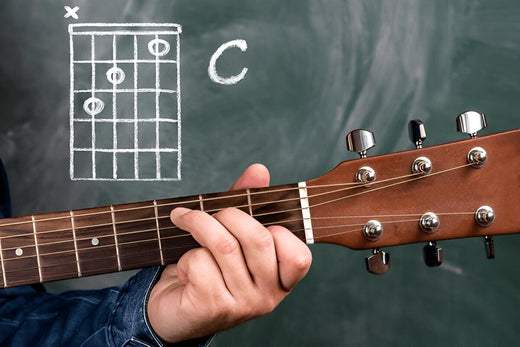I know you’ve seen them too, players the size of Keith Urban going out on stage to thousands of screaming fans with a reverse-headstock telecaster neck on their guitar. But, why reverse-headstock guitars have become increasingly popular?
Well, there was this man who revolutionized guitar playing, Jimi Hendrix, who ruled the world with a reverse-headstock Strat. He was left-handed, so he didn’t have a reverse-headstock Fender neck but was playing a right-handed guitar upside down.
Yet, the image, the mojo, and the cool factor lingered on to these days. If you’re planning to join this tidal wave of reversed headstocks washing over the guitar world, you have to read this until the end.
Reverse Headstock Vs. Regular Headstock
What is a Reverse-Headstock Guitar?
First, let’s address the most important question about this topic. A reverse-headstock guitar is simply an instrument sporting a neck that ends in a reversed headstock. If it’s a right-handed guitar, it’ll have a left-handed headstock, and vice versa.
The strings, though, will be in regular right-handed order; it’s not the entire guitar that’s left-handed, just the headstock.
This is, of course, only applicable to 6-in-line headstocks because 3+3 headstocks don’t really have an up and a down.
So, while the tuners on a regular 6-in-line headstock are on top, on the reverse-headstock version, they’re on the bottom. This is what happens with a Strat reverse-headstock neck, for example.
What is the Benefit of a Reverse Headstock?
The question is a reverse headstock better? Isn’t the one we’re about to answer. The benefits of reverse-headstock necks we’re about to discuss are rooted in performance and can be useful for some players while others might feel they’re drawbacks.
To begin with, a reverse-headstock neck changes the distance between the nut and the tuners (given you don’t have a double-locking tremolo system installed). While in a regular guitar neck, the string that covers the smallest distance is the thickest one, in reversed-headstock necks, this is the exact opposite.
This creates a difference in the string’s tension and, therefore, the feel of the guitar. So, for example, a Jackson reverse-headstock neck helps shredders and metal players allowing them to have more tension on the thickest strings, making them more stable, and tolerating the down-tune chugging.
Likewise, the thinnest strings on the guitar have less tension, making it easier to bend them.
If you play a Telecaster reverse-headstock neck, for example, you’ll have more tuning stability and tension to play chords, power chords, and open chords. The lowest strings will be more stable. Yes, the chicken picking never sounded better, just like Keith Urban’s.
Does a Reverse Headstock Change Tone?
Besides affecting the string tension and the feel of the instrument, does a reverse headstock affect tone? Well, the straight answer to this question is no. That said, string tension affects the way you play, and therefore, might make you play a little differently, but it shouldn’t affect the instrument’s tone.
So, if you were to buy a Warmoth roasted maple neck with a reverse headstock or a straight headstock, the results, tone-wise, should be identical.
Well, but then what does a reverse headstock do? First of all, it’s the killer looks, and then the change in the string tension. Other than that, there should be no difference.
Reverse Headstock Vs. Left-Handed Neck
A reverse-headstock neck isn’t the same as a left-handed neck.
A reverse-headstock, right-handed neck is a neck that has all the appointments of a right-handed neck but with a reversed-headstock. So, the marking dots are on top, and the nut is made for right-handed string order.
But, for example, if you wanted a reversed neck for your Telecaster, where would you get an original reversed-headstock Tele neck?
A possible solution is to buy a left-handed neck and use it upside down. You’ll have the reversed headstock looks and could play it as a right-handed neck.
So, the question is, can you put a left-handed neck on a right-handed guitar? Well, of course, you can, and it will engage the mojo factor of the reversed headstock.
There are three cons to this approach, though.
• The nut – Guitar nuts are cut for the size of string that’s going through each slot. So, if you buy a left-handed neck, you’ll have to change the nut to accommodate the right-handed strings. There’s no way on earth that you can make a low E go through a high E string slot.
• The truss-rod – The truss-rod is one of the most important parts of the guitar neck, it’s paramount for the setup and proper functioning of the guitar. Well, it’ll be reversed, therefore, you might risk turning it instinctively in the wrong direction.
• The marking dots – The marking dots on top of the neck (not the ones facing the audience, but the ones facing you), are your best friends on dark stages and long playing sessions. Well, they’re right above the neck so you can see them as you play. If the neck is left-handed, it’ll face the floor and be of no use to you.
Finally, and as a minor detail, some players find themselves a little lost when tuning a guitar with a reverse headstock. This is because the furthest tuner is used for the low E while the closest tuner is for the high E, opposite to most guitars.
These key differences make this a big decision. In the case of Jimi, well, getting left-handed guitars is difficult now, imagine back in the mid-‘60s. But he didn’t just flip the neck, he had no choice but to flip a right-handed guitar upside down entirely, including the whammy bar and the controls.
Can a Left-Handed Person Play a Right-Handed Guitar Upside Down?
Yes, perhaps Jimi Hendrix is the best example. Jimi played right-handed guitars upside down and strung as left-handed (with the low E on top and the high E on the bottom). But he was not the only one, Kurt Cobain did it too.
Furthermore, some players don’t even change the string position and play the guitar with the strings in their original location. This means the high E on top and the low E on the bottom, and inverted scales and chords.
The most prominent players to play like this in the scene today are Doyle Bramhall and Eric Gales.
They not only play right-handed guitars upside down, but they also do it with the strings as a right-handed player.
Reversed-Headstock Necks and Tuners
If you happen to buy a reversed-headstock neck for your project without the tuners, bear in mind that you need tuners to match the holes. In other words, you need left-handed tuners.
Head over to our tuners shop and find the best locking and non-locking models. As the saying goes, no matter what you play, if you’re out of tune, nobody wants to listen to you.
So, get the reversed-headstock mojo and add some Guyker precision to the combo.
Conclusion
The guitar world never really recovered from the coolness, vibe, mojo, and amazing pyrotechnics of Jimi’s playing. He’s still quoted as a major influence by many of the best players on the planet and his songs are covered by guitar legends from SRV to John Mayer to Gary Moore.
So, if you want to have at least the looks of this guitar God, then a Fender Stratocaster reverse-headstock neck could be a great choice.
Happy (reverse-headstock) playing!
If you like this article, please share it!
Be sure to join our FB Group Guyker Guitar Parts VIP Group to share your ideas! You can also have connections with like-minded guitar players, Guyker updates as well as discounts information from our FB Group.





